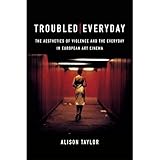Troubled Everyday : The Aesthetics of Violence and the Everyday in European Art Cinema / Alison Taylor.
Material type: TextPublisher: Edinburgh : Edinburgh University Press, [2022]Copyright date: ©2017Description: 1 online resource (144 p.) : 25 B/W illustrationsContent type:
TextPublisher: Edinburgh : Edinburgh University Press, [2022]Copyright date: ©2017Description: 1 online resource (144 p.) : 25 B/W illustrationsContent type: - 9781474415224
- 9781474415231
- 791
- PN1995.9.V5 T39 2017
- PN1995.9.V5 T39 2017
- online - DeGruyter
- Issued also in print.
| Item type | Current library | Call number | URL | Status | Notes | Barcode | |
|---|---|---|---|---|---|---|---|
 eBook
eBook
|
Biblioteca "Angelicum" Pont. Univ. S.Tommaso d'Aquino Nuvola online | online - DeGruyter (Browse shelf(Opens below)) | Online access | Not for loan (Accesso limitato) | Accesso per gli utenti autorizzati / Access for authorized users | (dgr)9781474415231 |
Frontmatter -- Contents -- Acknowledgements -- List of Figures -- 1 'A lightning that illuminates the banal': Violence and the Everyday -- 2 Everyday Moments -- 3 Everyday Style -- 4 Everyday Structures/Everyday Language -- 5 Return to the Everyday -- Conclusion: Looking Back -- Works Cited -- Filmography -- Index
restricted access online access with authorization star
http://purl.org/coar/access_right/c_16ec
Investigates the framing of the ordinary and the everyday in extreme European art filmExtreme violence in contemporary European art cinema is generally interpreted for its affective potential, but what about the significance of the everyday that so often frames and forms the majority of these films? Why do the sudden moments of violence that punctuate films like Catherine Breillat's Fat Girl (2001), Gaspar Noé's Irreversible (2002) and Markus Schleinzer's Michael (2011) seem so reliant on everyday routines and settings for their impact? Addressing these questions through a series of case-studies, and considering notorious films in their historical and philosophical context, Troubled Everyday offers the first detailed examination of the relationship between violence and the everyday in European art cinema. It calls for a re-evaluation of what gives these films such affective force, and such a prolonged grip on our imagination.Case StudiesSalò or the 120 Days of Sodom (Pasolini 1975)Money (Bresson 1983)Come and See (Klimov 1985)The Seventh Continent (Haneke 1989)I Stand Alone (Noé 1998)Fat Girl (Breillat 2001)Irreversible (Noé 2002)Twentynine Palms (Dumont 2003)Michael (Schleinzer 2011)
Issued also in print.
Mode of access: Internet via World Wide Web.
In English.
Description based on online resource; title from PDF title page (publisher's Web site, viewed 24. Mai 2022)


